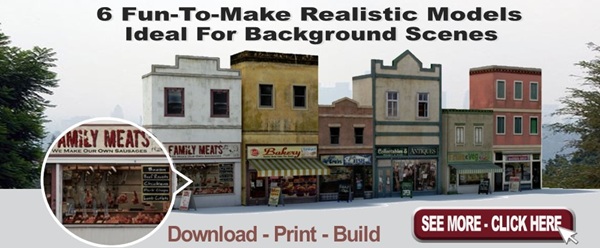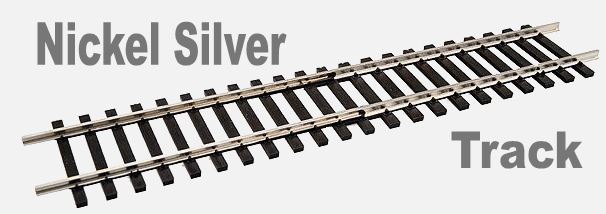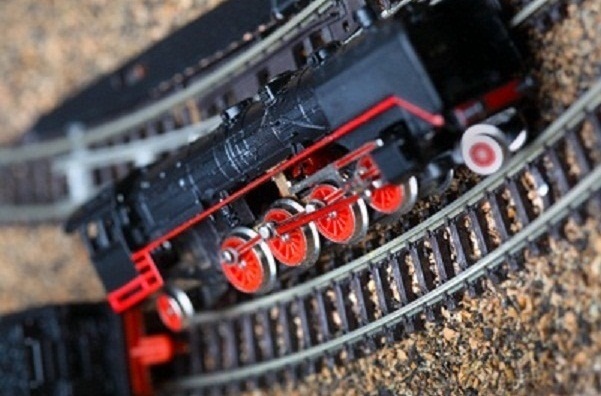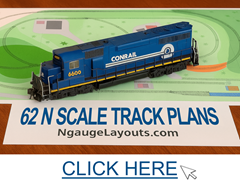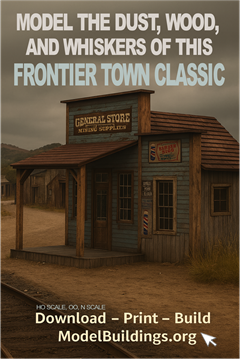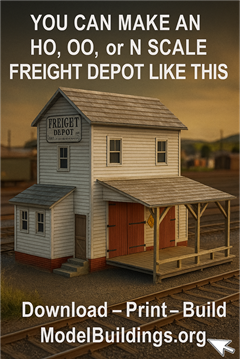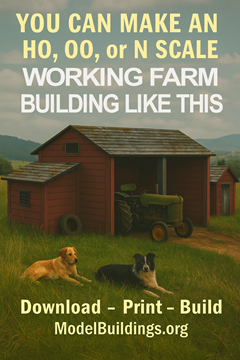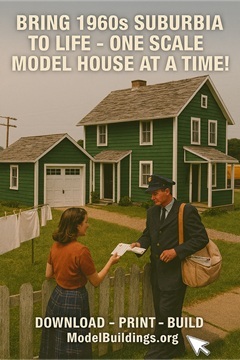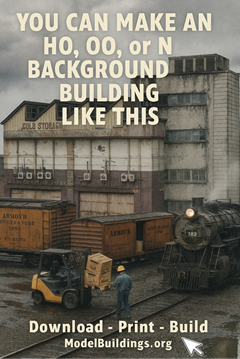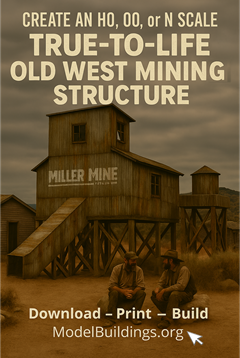Everything on model trains, model railroads, model railways, locomotives, model train layouts, scenery, wiring, DCC and more. Enjoy the world's best hobby... model railroading!
Model figures Add Life To A Scene
Model figures of people and animals can be used to give a realistic look when designing a railroad system. A layout doesn’t usually look complete until figures are added. My opinion is you can never have too many people on a model railroad layout. You can have people positioned on station platforms, working on farms, walking the streets, coming out of shops, working alongside the track… and not forgetting, driving vehicles. After all, a vehicle driving down a road without a driver looks a bit strange, and sometimes it is the little details (or lack of them) that can be the difference between a realistic looking railroad scene and one that just looks like an artificial model.
Figures are available in many types and forms. They can be made out of plastic and sometimes wood. Some of them are painted in a factory, some are hand painted and some are just unpainted so that you can choose your own colors. The passengers, ticket man, traffic controller, driver, guards and all others are available from various model railroad suppliers at reasonable prices.
The figures are manufactured according to common scales such as HO scale (1:87). Some companies also sell figures in non-standardized ratios.
Try the New ZOOM Tool
Try the new ZOOM tool to have a close-up view of these photo realistic model railroad buildings.
Waybill Systems
The purp ose of any railroad (real or model) is to transport freight and/or passengers efficiently from one place to another be it a port, railway station, or a rail yard where the freight can be delivered directly to a local industry.
ose of any railroad (real or model) is to transport freight and/or passengers efficiently from one place to another be it a port, railway station, or a rail yard where the freight can be delivered directly to a local industry.
There are various car forwarding systems available for railroad modelers to use, ranging from simple colored tabs attached to the cars through to to electronic waybill systems. There are advantages and disadvantages for each system and much depends on personal preferences. Some systems will allow for a “random flow” of cars whereas other systems work to maintain a “disciplined flow” of a specified car numbers in or out of particular zones as a way of balancing the traffic.
The system you use is really over to you, so it is best to choose the system that best meets suits your railroad or your own preferences based on what interests you most.
A waybill and car card system is very easy to set up. The basic steps are as follows:
–> Start by making a complete inventory of all your rolling stock
–> Print the car cards
–> Draw up a chart listing the various interchanges and industries
–> Decide the capacity of your layout and the best way of balancing the rolling stock
–> Print your waybills
–> Set up the car cards and waybills
–> Get the system working and start operations
Try and create a system with records you can keep and maintain through the time you have your layout. This is because when you buy new rolling stock, or alter the layout track work, it will potentially affect the dynamics of the system you have in place. Record any deletions, additions, or changes and change your waybills accordingly to ensure the system continues to operate efficiently.
A simple computer spreadsheet is suitable for listing the details. If you don’t have a computer spreadsheet you can draw up some tables on paper and keep them in a ringbinder. Keep accurate records and a system you can continue to use in years to come.
You can record the road name, road number and initial, the car type and description, along with any additional information such as the manufacturer, the cost etc.
If you prefer to use a more automated system, there are switch list systems that generate lists of freight and passenger cars to switch to allow you to achieve realistic train operations.
Model Train Collection
Manfred sent in this photo of his layout to share:
I have a Marklin layout 4 feet by 8 feet. Most of it dates back to the 1950’s ,but I have engines from the 1930’s . They run on AC on a three rail system as I grew up with it. I also have a large Lionel O collection – old and new. My oldest train is a Bowman live steam from 1902. It runs perfectly on a straight track. This winter was a perfect winter to operate the trains and I find it a fun hobby.
Add your comments.
If you would like to have a photo of your layout published, then please write a short article telling readers about your layout. Use the form at http://www.model-train-layouts.net/Submit-An-Article.html
Tips for a Successful Mainline Operation
Tony W sent in his ideas on operations:
It is easy to spend days or weeks designing a railroad layout, but the key is not to just get carried away with planning the scenery. From my experience successful operation is critical if the railroad is to function effectively. A few tips for managing operations and meeting scheduled target are given below.
–> Locate your stations close to the passengers and storage places, which will be using the service.
–> Link adjoining stations through straight tracks. This minimizes the running time.
–> Use simple siding if the train has to load and unload cargo.
–> Use fiddle yards to store trains, which are not being used for the time being.
Add your comments.
Laying the Rail Road Track
Club member Larry sent in this tip:
Laying the track is one of the most important aspects of building a railroad model. Design the entire track on paper first. Once done, loosely place the sectional and curved pieces to get the whole idea of the layout. Do not join any pieces at this point. For curved tracks, choose a radius that is bigger than the size of the train.
You can now proceed with joining the track. Start at one end and work on small sections at a time. Fasten the track down. Soldering is a good option to finish off the track because it prevents derailments.
Add your comments
Frankford Subway Elevated Line – South Eastern Pennsylvania
This photo kindly supplied by Fred was taken in Philadelphia Pennsylvania. Fred says, “It the Market -Frankford Subway Elevated line of the South Eastern Pennsylvania Transportation Authority (SEPTA) aka The Blue Line. This line’s track Gauge is 5 ft 2 1/4 Inc Gauge. Its aka is Keystone Gauge. The line is not far from where I used to live back in the day when parts of this line was captured in the Movie “Rocky” Sylvester (The Italian Stallion) Stallone.”
Add your comments.
Advantages of Using Nickel-Silver Tracks
Supplied by club member Warren:
Nickel – Silver is a composition of copper and nickel, with copper being the dominant metal. It is similar to brass but has added advantages. When brass oxidizes, a layer called rust is formed. Rust does not allow electrical conductivity. Consequently, if brass tracks are used, trains may not run smoothly. Regular cleaning and removing of rust is essential.
Nickel-Silver tracks also oxidize after a time. The difference is that nickel silver track has a higher current flow resistance than does brass track. This can necessitate more wiring to adequately feed the track.
Add your comment.
Hopper Cars Add Character To A Layout
Hopper cars are cargo trains, which are used to transport materials like coal, ore and crops. Hopper cars are distinguished from other freight trains because they are automated. An opening at the bottom allows them to load and unload cargo easily. The opening trap door is angled and uses gravitational force to deposit goods. No extra mechanisms are required for the purpose.
Hopper cars are classified into two broad categories; open car and closed car. Open cars are used when the weather does not have an adverse effect on consignments such as coal. Closed cars are used when goods need protection from rain and water such as sugar.
Add your comment.
Fred Shares His Loco Photos
Fred sent in these photos to share and says:
“I have been a rail enthusiast or train spotter as you guys call us since my draft bait days or as you refer to it as National service in my travels I served in Vietnam and Germany I now reside in The Orlando Florida area I used to live in Philadelphia PA. If you ever visit Philly Bring a lot of memory cards or plenty of film or both I have been doing 35 mm photography since my active duty days Color Slides for the most part a lot of my been there and done that’s are Boston Atlanta Ga, & Savannah Ga. Plant City Florida Steamtown USA in Scranton PA. Black River & Western IN Ringoes N.J. Atlantic City N.J and San Diego I really want to share some of my back in the day stuff I hope you guys like these These are at Frankford Junction in Philly I used to live a 10 minute drive 20 minute walk from his location I hope you guys like these.”
Add your comment.
5 Questions From Readers
Although a couple of these questions provide few details, hopefully a reader might be able to assist.
1. John asks readers:
OO Scale Tender Keeps On Spining
Why does my tender keep on spining? It is tender driven and sometimes it runs okay, then it stops then spins like mad. Is it the cogs? It’s brand new. Any ideas?
2. James asks:
HO Bachmann DCC Control
“I turn on the power and I get blinking red lights, but the engine will not run. I checked my wiring and can’t locate a problem. What would be the cause?”
3. Bernie asks readers:
L-Girder Tables – N Scale
“Does somebody out there know where I can get a diagram of how to cut a 4×8 3/8 plywood to make a table as well as directions on how to assemble and a part list of bolts nuts washers screws glue height adjusters?”
4. Denny asks readers:
Airport Ideas
“I want to add a local airport to my HO layout. Where can I buy 1:100 scale single engine aircraft?”
5. Jean asks readers:
Derailment at Point on Curve
I have a point at the beginning of a curve and the OO engine derails at this point every time – any suggestions – unfortunately I have had the pints wired up and are fixtures. Help please?”
Add your comments.
Tips to Avoid Model Train Derailments
Derailments are frequent and very annoying when you are trying to build a perfect railroad track. Here are a few tips to avoid them.
–> The joints must be well aligned and the gap between them must be kept to a minimum. The track should be smooth when you rub a finger over it.
–> Solder your sectional pieces in the end so that they remain fixed at one position.
–> The track gauge should neither be tight nor wide. If the track gauge is too tight the wheels could ride up and cause a derailment. If it is too wide the wheel flanges won’t span the track correctly, potentially causing a derailment. Heating the rail with a soldering iron can allow for the rail to be adjusted into position.
–> Make sure the switch points don’t grab the wheels. This sometimes happens with new switch points. A file can be used to carefully smooth the points (moveable parts) to achieve a smooth transition. Inspect the rail gauge when in each position.
–> The wheels must move freely and contact the rails evenly.
–> Ensure couplers don’t snag and are properly centered.
–> Check the length of your longest car if you are making an S-shaped track. It needs to be able to enter and exit the S curve without derailing.
–> Add additional weight to cars if they are too light. Aim for a low center of gravity with the weight in the towards the centre of the cars.
–> Lubricate frequently. If wheel sets are incorrectly aligned, out of gauge, or not rotating freely, they could cause a derailment. However, use oil sparingly as it does attract dust.
Add your suggestions and comments.
Model Railroading – Then and Now (infographic)
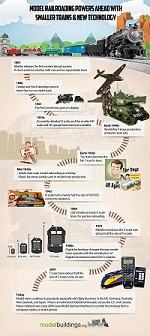 If you have never heard the term “infographic” it basically refers to information that is presented as a graphic. Infographics are an easy and interesting way to learn new things.
If you have never heard the term “infographic” it basically refers to information that is presented as a graphic. Infographics are an easy and interesting way to learn new things.
Here is an example of an fascinating infographic about the changes in Model Railroading through the years. It shows the trends and how the hobby is developing. It makes for interesting reading and is well worth sharing with friends.
Click here to view the infographic full size.
Also, if you have a website, facebook page, or blog you can publish the full size infographic provided it is not altered in any way. Details are on the webpage when you click the link above.
Enjoy!
Rewiring Locomotives
Brent from the UK sent in this tip:
I have a roll of magnet wire I use for rewiring locomotives and on rolling stock. This type of wire is normally used in the coils for twin solenoid switch machines and in motors. You will need to scrape away the enamel coating prior to using it. I find that small flexible wires are best on rolling stock.
Add your comments.
Steps to Prototypical Designing
![]() If you are new to model trains, then you’re at a loss about where to start from. Prototypical designing is just for people like you. It allows the entire railroad to be modeled according to a real system. This eliminates possibilities where trains might not be on schedule or not operate at all.
If you are new to model trains, then you’re at a loss about where to start from. Prototypical designing is just for people like you. It allows the entire railroad to be modeled according to a real system. This eliminates possibilities where trains might not be on schedule or not operate at all.
- Use Google maps to get an idea of real tracks. Take any system you like as your guide and model your track according to it.
- Find out train operations of the track you choose.
- Compress the model according to a suitable scale.
- You may use software to find the credibility of your design, before preceding with the actual model.
What Do You Mean By Layout Ground Cover?
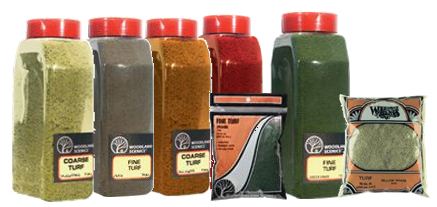 The layout ground cover is basically the ‘vegetation’ or landscape that covers the outer surface of your model train layout and is intended to hide the plaster, wires and form that coat your terrain. Layout Ground Cover is a very important part of your scenery and is vital to bring out the realism in the whole project.
The layout ground cover is basically the ‘vegetation’ or landscape that covers the outer surface of your model train layout and is intended to hide the plaster, wires and form that coat your terrain. Layout Ground Cover is a very important part of your scenery and is vital to bring out the realism in the whole project.
The layout ground cover is divided into – low, medium and high. The low area incorporates the coloring of the surface with small elements like grass, and other plants. Medium includes taller plants like weeds, medium sized vines and bushes. High on the other hand includes tall grasses, larger bushes and shrubs.
A great tip in creating layout ground cover is to use a variety of textures and shades to bring a much more realistic outlook than the use of a single shade of color. The realism of the layout ground cover totally depends upon the imagination of the modeler.
I wish I Could Sketch Like This!
Watch this short video if you are thinking about constructing some model buildings for your layout.
Enjoy!
